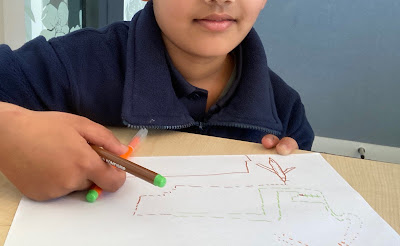Working with small groups

I feel so lucky to be learning so much from the kids that I teach. Two of our students taught me new games that they had played during their art therapy time. The first game involves drawing 6 doodles / scribbles / shapes and numbering them 1-6. Then each person takes a turn to roll a die. If the die lands on a 6, that person copies the doodle that is labelled '6'. This continues until one player draws all 6 doodles on their paper. The game seems to help students take turns and interact positively with each other while also creating a drawing in a structured way. Another drawing game involves drawing a large circle or square (over most of the paper) and dividing it into parts. If there are 3 players, divide the shape into 3 parts. If there are 4 players, divide the shape into 4 parts. Decide how many minutes you will get to draw your first picture (1-3 minutes seems good). Then each person draws their first picture in one of the sections. Then w...





